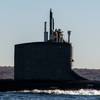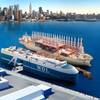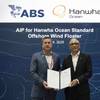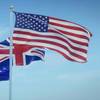Researchers Develop Underwater Observatory
The vastness of the sea and its sometimes harsh conditions often pose a challenge to marine researchers. In the North Sea near Heligoland, scientists from the Thünen Institute for Sea Fishing, the Alfred Wegener Institute (AWI) and the Helmholtz Center Geesthacht (HZG) have now installed an extraordinary device: an optical-acoustic underwater observatory. It is capable of capturing and automatically identifying the smallest marine life underwater - around the clock and even under conditions where no research ship can leave the port.
Microscopically small creatures, fish larvae, jellyfish as well as youth stages of many snails and echinoderms - all this is counted as zooplankton. It is the basis of the food chain in the sea, its distribution and diversity is thus also of great importance for many fish stocks and sea mammals.
The zooplankton observatory is able to automatically detect the distribution patterns of the micro-organisms and particles with a high spatial and temporal resolution, without affecting the living communities by means of fishing gear or samples. In addition, it can register the distribution and sink rate of small organic particles, the so-called "snow of the oceans". These particles are an important component of the carbon fluxes in the oceans and thus have an influence on the climatic conditions as well as their change.
The underwater device is based on the combination of an acoustic Doppler flow meter (ADCP) with a video plankton recorder (VPR). The latter is an underwater camera system that can capture 15 high-resolution images per second. This makes it possible to observe and determine organisms from a size of 0.5 millimeters - even fragile species such as gelatinous plankton, which is often not detected in the traditional sampling with plankton. The ADCP provides a three-dimensional measurement of the flow field and measures the acoustic back-up level. With the aid of this data, daily or seasonal migration patterns of zooplankton communities can be investigated and migration rates can be determined.
The zooplankton observatory was developed by Dr. Boris Cisewski from the Thünen Institute for Sea Fisheries and Dr. Klas Ove Möller from the Helmholtz Center Geesthacht (formerly the Institute for Hydrobiology and Fisheries Science of the University of Hamburg) with the help of specialized marine technology companies. At the end of November, the scientific diving center of the AWI, with the help of the water and shipping office Tönning, was used for the water protection ship "Neuwerk".
The new zooplankton observatory now supplements the underwater node developed by the Helmholtz Center Geesthacht and the Alfred Wegener Institute as part of COSYNA (Coastal Observing System for Northern and Arctic Seas) and put into operation in the AWI underwater field Margate in 2012, north of Heligoland has been. This underwater node - an underwater power socket for power and internet access under water - offers the possibility to connect different sensors and devices under water and to operate them remotely via short or long-term access. The node is operated by Prof. Philipp Fischer, scientist at the AWI, in collaboration with the Helmholtz Center Geesthacht, in order to examine and measure the fish fauna and bodie animals. The Zooplankton Observatory ideally complements the measurement instruments that have already been deployed and is now intended to supply data for several months.
The three responsible scientists want to use the optical-acoustic data provided by the new zooplankton observatory together with the long-term data set "Helgoland Reede", which was collected by the AWI, for further joint research. "Helgoland Reede" is one of the most valuable and detailed marine data records in the world, where measured values of temperature, salt and nutrient content as well as the occurring animals and plants are analyzed.
The Zooplankton Observatory was developed as part of the Collaborative project "AutoMat" ("Adaptation and further development of innovative, non-invasive monitoring systems and evaluation methods for fishery research"). AutoMAt was funded by BLE (Federal Institute for Agriculture and Food).













